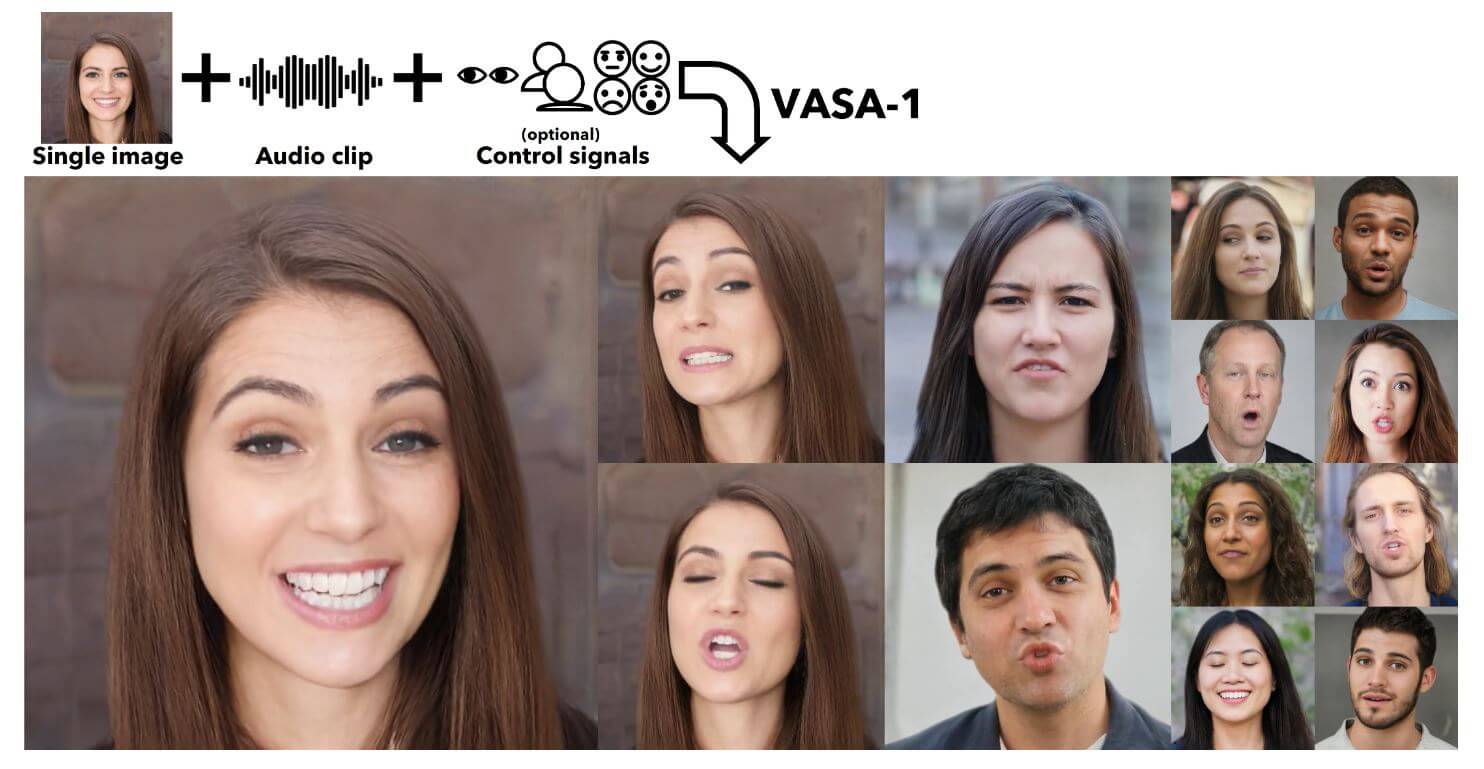Introduction:
Have you ever wished a photograph could speak and express emotions just like a real person? This dream is now becoming a reality thanks to Microsoft AI model VASA-1 AI. VASA-1, short for Visual Affective Skills Animation, is an advanced AI tool that can convert a single still image into a video where the person in the image appears to speak and move in perfect sync with a provided audio clip. This technology offers exciting opportunities for a new era of AI-driven content creation, spanning from creative storytelling to educational materials and beyond.
By reading further, you’ll discover how this innovative tool can be applied in a variety of ways and how it could change the way we think about video creation.
What is Microsoft AI VASA-1?
VASA-1 is a cutting-edge AI tool developed by Microsoft that takes image-to-video transformation to the next level. Imagine showing a single photograph to the AI, and it returns a short video where the person in the photo talks and moves their face naturally. The AI analyzes the image along with an audio clip, generating realistic lip movements and facial expressions that perfectly match the speaker’s voice and tone.
This technology offers a lot of potential for various industries. In education, VASA-1 could make learning materials more engaging by bringing historical figures or concepts to life. In entertainment, it can offer filmmakers new ways to create compelling narratives using limited resources. Social media platforms could benefit from unique content that keeps audiences engaged.
VASA-1 doesn’t just create videos; it transforms how we interact with visual content. It opens up new possibilities for storytelling and information sharing across multiple platforms. By using this AI tool, creators can produce more immersive and interactive content, giving viewers a fresh and exciting experience.
How Does the Microsoft AI Model VASA-1 Work?
The magic of VASA-1 lies in its advanced deep-learning capabilities. Microsoft AI researchers trained the model using large datasets of images and videos, teaching it how to recognize and understand complex relationships between facial features, emotions, and speech patterns. Here’s a simplified look at how the process works:
Input: To get started, you provide VASA-1 with a single portrait image and an audio clip.
Facial Analysis: The AI carefully studies the image, identifying key facial features like the eyes, nose, and mouth.
Speech Processing: VASA-1 listens to the audio clip, extracting information about the speaker’s tone, pitch, and rhythm.
Video Generation: With its deep learning knowledge, VASA-1 creates a video sequence. It animates the facial features in the image to match the audio, producing realistic lip movements and subtle expressions that reflect the emotions in the voice.
In short, VASA-1 uses its deep learning skills to bridge the gap between images and audio, resulting in a seamless and natural video. This process allows for the creation of engaging content that can be used in a variety of settings, from storytelling to educational materials and beyond.
What Can the VASA-1 AI Model Do?
VASA-1 is a versatile AI model that brings still images to life by transforming them into talking pictures. It does an exceptional job of lip-syncing, ensuring that the character’s mouth movements align perfectly with the provided audio. But VASA-1 doesn’t stop there. It offers even more impressive features:
Generate Facial Expressions: The model can animate subtle facial expressions such as frowns, smiles, and raised eyebrows. These nuanced expressions add realism and emotional depth to the video, making the character naturally come to life.
Control Head Movements: VASA-1 doesn’t just focus on the face; it also animates head movements like nods and tilts. This gives the character a more dynamic and believable presence on screen, making the video more engaging and relatable.
In essence, VASA-1 provides creators with the tools to transform still images into vivid, expressive videos. This AI model can be a game-changer in various fields such as education, entertainment, and social media by capturing the intricacies of human speech and emotion.
Applications of VASA-1 AI Model
The VASA-1 AI model offers exciting possibilities across various industries by transforming photos into videos with AI. Here’s a closer look at some of its applications:
Personalized Avatars: VASA-1 can create lifelike avatars for virtual assistants or chatbots, making interactions more engaging and personalized. Imagine chatting with a virtual assistant that feels almost human.
E-learning and Education: The model can bring historical figures to life in educational videos, making history lessons more immersive and interactive. It can also create personalized learning materials tailored to individual students, enhancing the overall learning experience.
Film and Entertainment: VASA-1 can be used to animate characters in movies, video games, or even personalized greetings from celebrities. This opens up new creative avenues for filmmakers and game developers, allowing for more dynamic and expressive characters.
Social Media: The ability to generate short talking videos from selfies could change the way we interact on social media. Users can create engaging, personalized content that resonates with their audience.
Microsoft AI for Creating Videos
Microsoft AI model VASA-1 introduces a new approach to creating videos that is both efficient and accessible. Here’s how VASA-1 is beneficial:
Accessibility: VASA-1 simplifies the video creation process, allowing users to generate videos without requiring advanced editing skills. Whether you’re a professional creator or just someone looking to bring a still image to life, this AI model offers a user-friendly experience.
Efficiency: Generating short videos with VASA-1 can be much quicker compared to traditional animation methods. This can save creators time and resources, making the process more streamlined.
However, there are important ethical considerations to keep in mind:
Deepfakes: The technology behind VASA-1 could potentially be misused to create realistic deepfakes, which could spread misinformation or cause harm.
Privacy Concerns: Using personal images to generate AI videos raises privacy questions. It’s essential to be cautious about whose images are being used and how they are being transformed.
Turn Photos into Videos with AI
VASA-1’s introduction marks a significant advancement in AI-generated videos. As this technology evolves, we can anticipate even more exciting possibilities:
Higher Resolution Videos: Right now, VASA-1 creates videos with a resolution of 512×512 pixels. Future updates could lead to the generation of high-definition videos that are almost indistinguishable from real footage. This would enhance the overall quality and realism of AI-generated videos.
Real-Time Processing: Imagine the potential of VASA-1 generating talking videos in real time. This could pave the way for applications like live video conferencing with animated avatars, making virtual interactions even more engaging and lifelike.
Conclusion:
In conclusion, the Microsoft AI model VASA-1 represents a major leap in transforming still images into videos with natural speech and expressions. This advanced technology opens up new avenues for creativity and innovation across various industries such as education, entertainment, and social media. VASA-1 simplifies the process of video creation, allowing even those without advanced editing skills to bring static images to life.
However, with this groundbreaking technology come important ethical considerations. The potential misuse for creating deepfakes and concerns about privacy must be carefully managed to ensure safe and responsible use. As VASA-1 continues to develop, we can look forward to higher-resolution videos and real-time processing, expanding its applications even further.
Overall, VASA-1 has the potential to transform the way we create and interact with visual content, offering creators and audiences a more immersive and engaging experience. By embracing this technology thoughtfully and ethically, we can harness its full potential and enjoy its benefits for years to come.

